alabamathirteen is a self-taught disabled artist based in Leeds, UK. Through her work she explores her fascination with bodies, spaces and horror, and draws on her own personal limitations; navigating her memories and senses in the spaces she occupies as a disabled woman, underpinned by the notion of ‘non-conforming’ bodies as an act of defiance.
Court Spencer caught up with her during her residency at The Art House in Wakefield.
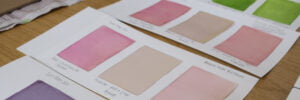
Anthotype emulsion tests at The Art House
Court: Thank you so much for having me! This was perfect timing to do this interview whilst you’re doing this residency. I suppose it makes sense to start with that! So, what’s the residency, how did you get it and what are you doing?
alabama: The residency is a collaboration between The Art House and Outside In, a national charity that provides a platform for artists who face significant barriers to the art world due to health, disability, social circumstances or isolation.
The residency was open to any Outside In artist, and those who fit the criteria of the charity, who wanted the opportunity to develop and progress their practice through a residency. In order to apply I had to submit a personal statement and proposal of the work I’d like to undertake during the residency. I believe it was quite competitive, so I was genuinely quite surprised (and delighted!) when I found out that my application had been successful last December.
My residency is being split in two parts over the year and I’m exploring alternative photographic processes. I am particularly interested in the impermanence of unfixed processes as a way to explore my thematic interests in the transient nature of experiences and memory. I’m also keen to develop a more sustainable practice that is kinder to the environment (and my allergies!) by using more plant-based materials and natural elements to create images. So I’m here for two weeks in May and will be returning later in the year, when the new community darkroom facilities are open and I can continue exploring alternative photographic processes.
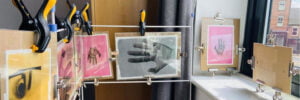
Exposing anthotypes at The Art House. Credit: alabamathirteen.
Court: And so when you’re not at The Art House, do you have a studio or where do you usually make your work?
alabama: I mainly work from a little studio space at home as due to my disabilities and medically suppressed immune system, even before lockdown was a thing, I was already a well practiced social isolator. In fact, the last time I left the house prior to this was a five day stay in hospital in October 2019! Though it did get a bit more extreme during lockdown as I was actually confined to a single room in my house whilst I was shielding, so over the last year or so everything I have created was made in my bed! One of the reasons the residency here at The Art House really appealed to me is because residencies are usually completely inaccessible to me due to my access needs and it was great to find an arts organisation that was able to accommodate them with accessible studio space and their accessible flat.
Court: Within your work there are some reoccurring themes you explore, can you talk us through some of those and how they’ve evolved?
alabama: The main themes that run through my work at the moment tend to centre around false narratives and distorted memories related to disability and trauma and ageing, and more broadly around exploring identity and the places and spaces we occupy in society; about whose voices get heard and whose voices get suppressed; about who gets to take up space and who is invisible. Increasingly I find myself linking this thematically to the representation of ghosts in horror films relentlessly unleashing a lifetime’s worth of rage and retribution, no longer subject to societal restrictions.
I use photographic processes a lot in my work as I’m really interested in questioning the permanence and what is widely held to be irrefutable truth and validity of photographic images. This is one of the reasons I have started gravitating more towards working with unfixed processes and exploring how this fits with my thematic interest in false narratives and impermanence.
Essentially most of the themes come from my own lived/living experience as an ageing, disabled, woman, but I like to think that they are relatable on a more universal level.
Court: Alongside photography, embroidery often features within your work. Why embroidery, and where has that come from?
alabama: I have always loved embroidery, I love that it has such a rich, and often subversive, feminist history. It also connects me to the spectre of generations past coming, as I do, from a long line of textile workers. I am particularly drawn to the repetitive and geometric shapes of black work embroidery and like to use them to add extra layers of distortion, abstraction and narrative to the photographic images I use in my work. I have developed a technique using invisible thread that is particularly effective at distorting images.
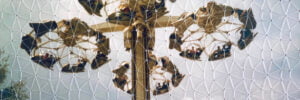
Detail from The Condor, 2020 embroidered photograph. Credit: alabamathirteen.
Court: You describe yourself as a disabled artist. How do you think your disability impacts on the art you make?
alabama: Disability is an integral part of my life and an integral part of my identity so it impacts on absolutely everything!
My art practice is very focused on creating a narrative around my relationship with an outside world that I’m very often excluded from. At the moment one of the things that is very much on my mind is that although the pandemic gave an insight into the isolation and barriers faced by so many disabled people, talk of returning to ‘normal’ highlights the fact that ‘normal’ was never an option for everyone.
For a lot of people with accessibility issues, our world opened up with the sudden introduction of online platforms for work and socialising that had previously been denied to us as too complicated/too burdensome to implement. And there is a real fear that those things that suddenly opened up will just as suddenly disappear again if it returns to only being a necessity for the minority.
I hope that my work will provoke conversations that challenge the pervading ideas about disability, and demonstrate that art by disabled artists can, and does, stand on its own merit in the art world.
An important strand that underpins my art more broadly is the politics of disability equality. Both in terms of constantly questioning how I can create work that can be experienced in different ways, by constantly working to improve my own knowledge and understanding of access needs beyond my own, but also in a desire to work with organisations who are committed to increasing the visibility of disabled artists and challenging the relentless exclusion of disabled people from arts and culture. We need to challenge the idea that certain groups are hard to reach as opposed to intentionally ignored because it’s a bit like hard work! For example, I have a personal rule that I won’t exhibit work in spaces I can’t physically access.
So yeah, disability impacts on my work because it’s such an integral part of who I am, in much the same way that being a largely self-taught, gobby, working class northerner does too!
Court: I suppose we’re all multifaceted! How do you think being a disabled artist impacted your lockdown experience? And what projects did you work on in that time?
alabama: As I mentioned, I was deemed ‘clinically extremely vulnerable’ so had to shield within my own home in a single room. I couldn’t even spend time with my partner who had to work throughout lockdown, or my daughter while she was attending school. Although probably one of the hardest parts was being reminded on a pretty much daily basis just how inconsequential and disposable so many people seem to think disabled people and our lives are so I didn’t always feel too creative to be honest. But eventually the boredom of staring at the same four walls, fuelled by some righteous rage, inspired me to start producing work again.
I became quite fixated by the view from my window and started producing a series of photos documenting my relationship with the outside world that I shared on Instagram, several of which will be exhibited in a group show at the Yellow Edge Gallery in June. I was also working a lot with Polaroid photos, it was very noticeable that as my world shrank so did the size of the work I was producing due to the confines of space I was experiencing.
Court: Speaking of the size of your work shrinking, you’ve been exhibiting in The House of Smalls, one of the doll house gallery spaces that came into prominence during lockdown. How have you found showing your work in that setting?
alabama: Yeah I’ve been involved with all of the exhibitions they’ve put on at The House of Smalls and have also showed as part of the Restriction exhibition by the Correspondence Collective. What I loved about these was that is gave the impression that my work was much larger than it really is, and it’s really inspired me to want to make my work on a much larger scale. Even for being in this studio as part of the residency I’m noticing the scale of my work increase.
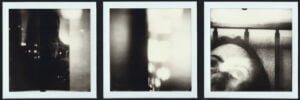
The Shielder, 2020 Polaroid Photographs. Credit: alabamathirteen.
Court: Your lockdown experience was so much more extreme than most! But it feels like you took some positives from it and really moved your practice forward during that time. What are your plans for the rest of the year?
alabama: It was very difficult at times but it gave me a lot of time to think about what it is I want to achieve in life and watching that time ticking away before my eyes definitely gave me an impetus to follow my dream to become a professional artist. Being able to connect with so many great disability arts organisations, like Outside In and DASH, a disabled led visual arts charity that has provided me with an art mentor, helped me feel less isolated and more supported in challenging the barriers I face as a disabled person and artist which has been invaluable to my practice.
It also inspired me to use the privilege that I have to put myself out there to amplify the voice of disabled people and artists, both as a trustee at Shape Arts, another disability-led arts organisation, and as a founding member of DISrupt, a collective of disabled artists in Leeds providing mutual support, knowledge sharing and collaboration opportunities as well as advocating for the arts in Leeds to be more accessible and inclusive.
In terms of my own practice, I will mainly be undertaking a period of thematic and process driven research after a successful application to the Arts Council ‘Develop Your Creative Practice’ funding stream. I will also be producing some work as part of a bursary I was awarded by a prestigious contemporary art organisation in Leeds (at the time of this interview this has yet to be publicly announced, hence the vagueness!). I am also working on a project with Outside In in conjunction with the Mental Health Museum in Wakefield, culminating in a group exhibition in 2022. And as I mentioned before I will be returning to The Art House at the end of the year to complete my residency, and to start finalising work for a solo exhibition there in 2022!
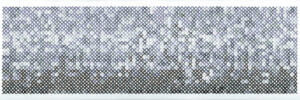
The Shielder, 2020 stitched soundscape. Credit: alabamathirteen.
Court: You sound super busy! And I know you’ve been working on your art career for some time but it feels like lockdown has contributed to moving it forward in some regards. So my final question is, do you have a dream project you would love to make happen at some point?
alabama: I always have a million ideas whirring around inside my head so there are lots of projects I would love to make happen! At the moment I am working towards making larger scale, more multi-sensory, immersive work so I have lots of ideas related to that! One of the things I would love to do is create a large-scale soundscape/immersive camera obscura room installation. And I would also really love to do some ridiculously enormous chlorophyll and anthotype installation pieces!
Thank you so much for your time. It’s really exciting to see the ideas you’re working with and the progression of your work. And I can’t wait for you to be able to announce your next project!
To see more of alabamathirteen’s work, head to her website or Instagram account.
Filed under: Art & Photography
Tagged with: alabamathirteen, art and photography, court Spencer, Disability, disabled artist, Diversity, embroidery, equality, exhibition, gallery, leeds, lockdown, Polaroid, residency, shielding, textiles, Wakefield
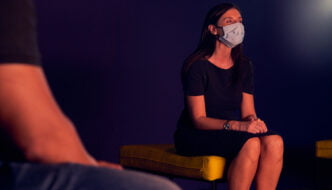
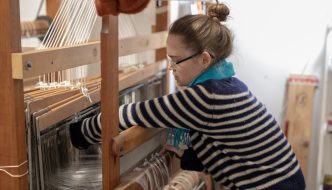
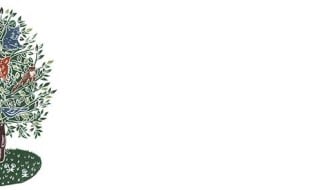
Comments